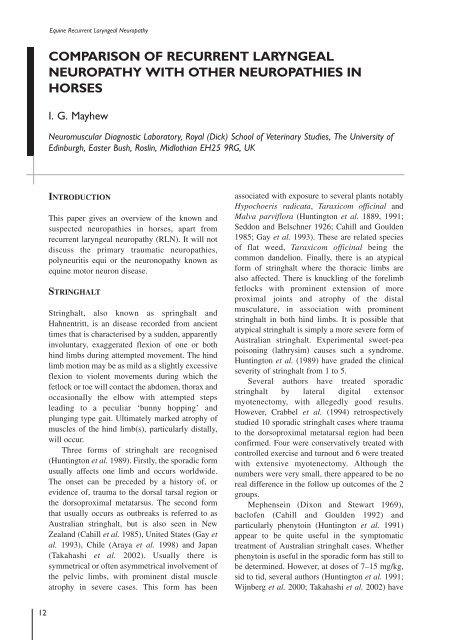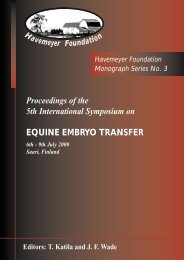Proceedings of a Workshop on - The Havemeyer Foundation
Proceedings of a Workshop on - The Havemeyer Foundation
Proceedings of a Workshop on - The Havemeyer Foundation
You also want an ePaper? Increase the reach of your titles
YUMPU automatically turns print PDFs into web optimized ePapers that Google loves.
Equine Recurrent Laryngeal Neuropathy<br />
COMPARISON OF RECURRENT LARYNGEAL<br />
NEUROPATHY WITH OTHER NEUROPATHIES IN<br />
HORSES<br />
I. G. Mayhew<br />
Neuromuscular Diagnostic Laboratory, Royal (Dick) School <str<strong>on</strong>g>of</str<strong>on</strong>g> Veterinary Studies, <strong>The</strong> University <str<strong>on</strong>g>of</str<strong>on</strong>g><br />
Edinburgh, Easter Bush, Roslin, Midlothian EH25 9RG, UK<br />
INTRODUCTION<br />
This paper gives an overview <str<strong>on</strong>g>of</str<strong>on</strong>g> the known and<br />
suspected neuropathies in horses, apart from<br />
recurrent laryngeal neuropathy (RLN). It will not<br />
discuss the primary traumatic neuropathies,<br />
polyneuritis equi or the neur<strong>on</strong>opathy known as<br />
equine motor neur<strong>on</strong> disease.<br />
STRINGHALT<br />
Stringhalt, also known as springhalt and<br />
Hahnentritt, is an disease recorded from ancient<br />
times that is characterised by a sudden, apparently<br />
involuntary, exaggerated flexi<strong>on</strong> <str<strong>on</strong>g>of</str<strong>on</strong>g> <strong>on</strong>e or both<br />
hind limbs during attempted movement. <strong>The</strong> hind<br />
limb moti<strong>on</strong> may be as mild as a slightly excessive<br />
flexi<strong>on</strong> to violent movements during which the<br />
fetlock or toe will c<strong>on</strong>tact the abdomen, thorax and<br />
occasi<strong>on</strong>ally the elbow with attempted steps<br />
leading to a peculiar ‘bunny hopping’ and<br />
plunging type gait. Ultimately marked atrophy <str<strong>on</strong>g>of</str<strong>on</strong>g><br />
muscles <str<strong>on</strong>g>of</str<strong>on</strong>g> the hind limb(s), particularly distally,<br />
will occur.<br />
Three forms <str<strong>on</strong>g>of</str<strong>on</strong>g> stringhalt are recognised<br />
(Huntingt<strong>on</strong> et al. 1989). Firstly, the sporadic form<br />
usually affects <strong>on</strong>e limb and occurs worldwide.<br />
<strong>The</strong> <strong>on</strong>set can be preceded by a history <str<strong>on</strong>g>of</str<strong>on</strong>g>, or<br />
evidence <str<strong>on</strong>g>of</str<strong>on</strong>g>, trauma to the dorsal tarsal regi<strong>on</strong> or<br />
the dorsoproximal metatarsus. <strong>The</strong> sec<strong>on</strong>d form<br />
that usually occurs as outbreaks is referred to as<br />
Australian stringhalt, but is also seen in New<br />
Zealand (Cahill et al. 1985), United States (Gay et<br />
al. 1993), Chile (Araya et al. 1998) and Japan<br />
(Takahashi et al. 2002). Usually there is<br />
symmetrical or <str<strong>on</strong>g>of</str<strong>on</strong>g>ten asymmetrical involvement <str<strong>on</strong>g>of</str<strong>on</strong>g><br />
the pelvic limbs, with prominent distal muscle<br />
atrophy in severe cases. This form has been<br />
associated with exposure to several plants notably<br />
Hypochoeris radicata, Taraxicom <str<strong>on</strong>g>of</str<strong>on</strong>g>ficinal and<br />
Malva parviflora (Huntingt<strong>on</strong> et al. 1889, 1991;<br />
Sedd<strong>on</strong> and Belschner 1926; Cahill and Goulden<br />
1985; Gay et al. 1993). <strong>The</strong>se are related species<br />
<str<strong>on</strong>g>of</str<strong>on</strong>g> flat weed, Taraxicom <str<strong>on</strong>g>of</str<strong>on</strong>g>ficinal being the<br />
comm<strong>on</strong> dandeli<strong>on</strong>. Finally, there is an atypical<br />
form <str<strong>on</strong>g>of</str<strong>on</strong>g> stringhalt where the thoracic limbs are<br />
also affected. <strong>The</strong>re is knuckling <str<strong>on</strong>g>of</str<strong>on</strong>g> the forelimb<br />
fetlocks with prominent extensi<strong>on</strong> <str<strong>on</strong>g>of</str<strong>on</strong>g> more<br />
proximal joints and atrophy <str<strong>on</strong>g>of</str<strong>on</strong>g> the distal<br />
musculature, in associati<strong>on</strong> with prominent<br />
stringhalt in both hind limbs. It is possible that<br />
atypical stringhalt is simply a more severe form <str<strong>on</strong>g>of</str<strong>on</strong>g><br />
Australian stringhalt. Experimental sweet-pea<br />
pois<strong>on</strong>ing (lathrysim) causes such a syndrome.<br />
Huntingt<strong>on</strong> et al. (1989) have graded the clinical<br />
severity <str<strong>on</strong>g>of</str<strong>on</strong>g> stringhalt from 1 to 5.<br />
Several authors have treated sporadic<br />
stringhalt by lateral digital extensor<br />
myotenectomy, with allegedly good results.<br />
However, Crabbel et al. (1994) retrospectively<br />
studied 10 sporadic stringhalt cases where trauma<br />
to the dorsoproximal metatarsal regi<strong>on</strong> had been<br />
c<strong>on</strong>firmed. Four were c<strong>on</strong>servatively treated with<br />
c<strong>on</strong>trolled exercise and turnout and 6 were treated<br />
with extensive myotenectomy. Although the<br />
numbers were very small, there appeared to be no<br />
real difference in the follow up outcomes <str<strong>on</strong>g>of</str<strong>on</strong>g> the 2<br />
groups.<br />
Mephensein (Dix<strong>on</strong> and Stewart 1969),<br />
bacl<str<strong>on</strong>g>of</str<strong>on</strong>g>en (Cahill and Goulden 1992) and<br />
particularly phenytoin (Huntingt<strong>on</strong> et al. 1991)<br />
appear to be quite useful in the symptomatic<br />
treatment <str<strong>on</strong>g>of</str<strong>on</strong>g> Australian stringhalt cases. Whether<br />
phenytoin is useful in the sporadic form has still to<br />
be determined. However, at doses <str<strong>on</strong>g>of</str<strong>on</strong>g> 7–15 mg/kg,<br />
sid to tid, several authors (Huntingt<strong>on</strong> et al. 1991;<br />
Wijnberg et al. 2000; Takahashi et al. 2002) have<br />
12








